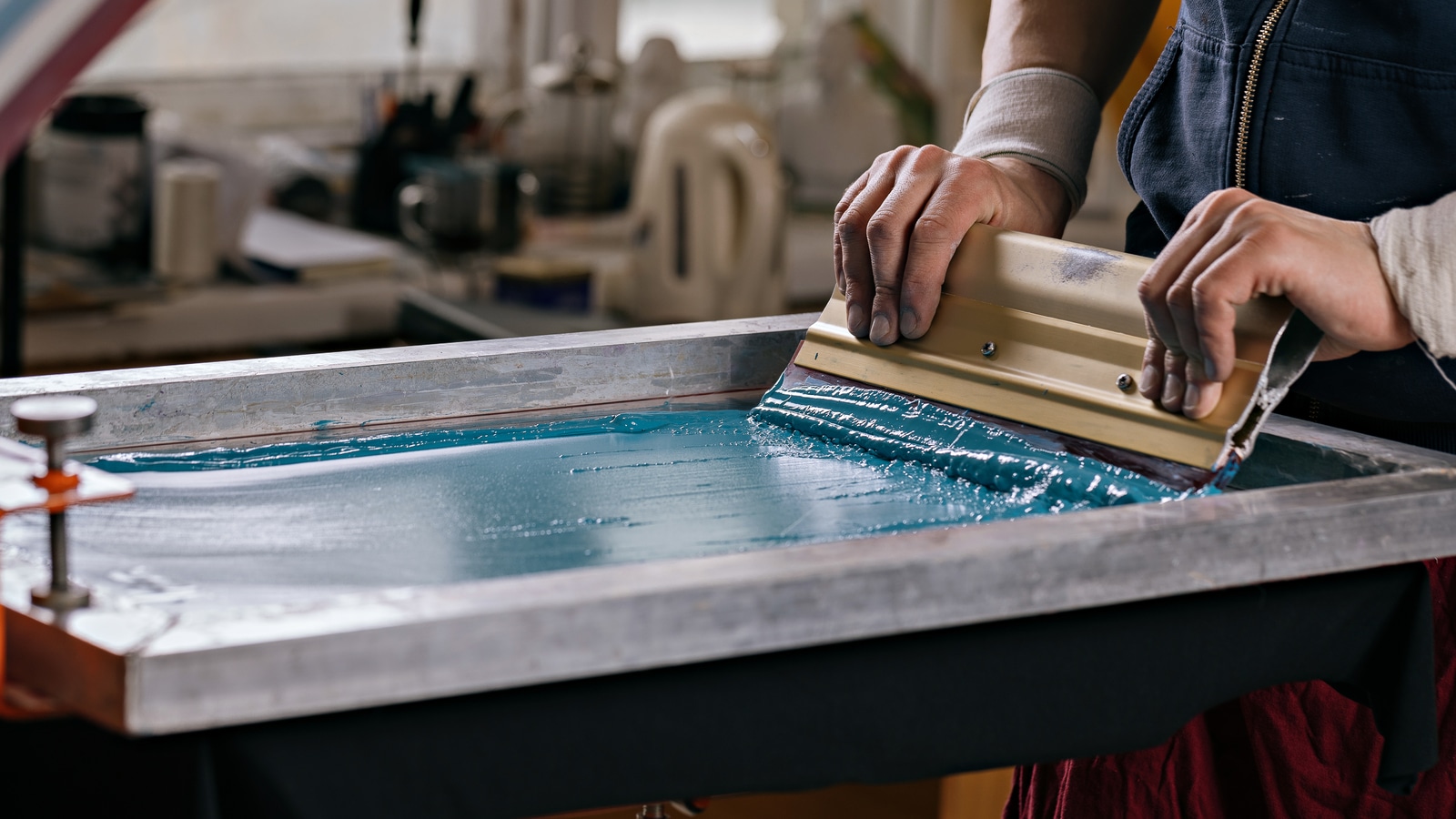Vintage Style Silk Screen Printing for Retro Fashion
Vintage Style Silk Screen Printing for Retro Fashion
Blog Article
Screen Printing Uncovered: Everything You Required to Know Concerning T-Shirt and Garment Printing Methods
Screen printing is a remarkable method that integrates art with strategy, offering limitless possibilities for creativity. All set to check out the important components that make display printing an art kind?
The Fundamentals of Screen Printing: How It Functions
When you plunge right into screen printing, you'll find it's both a scientific research and an art. At its core, screen printing involves producing a stencil, or display, that allows ink to pass with only in details locations.
Following, you'll mix your inks and prepare your printing surface. Setting the display over the material, after that utilize a squeegee to push ink via the screen onto the garment. This procedure requires accuracy, as you want clear, dynamic prints. After printing, you'll heal the ink with heat, ensuring it follows the material and lasts via washes. Each action is important, and mastering them will elevate your screen printing skills, changing easy garments right into special, meaningful pieces.
Types of Display Printing Methods
Once you grasp the fundamentals of display printing, it's time to check out the various methods that can elevate your designs. One prominent method is standard display printing, where ink is pressed via a stenciled screen.
Another choice is plastisol printing, recognized for its toughness and brilliant colors, making it a favorite for many brands. Experiment with halftone printing to produce slope impacts and complex styles.
Essential Devices for Display Printing
To attain stunning outcomes in screen printing, having the best equipment is basic. You'll need a durable screen printing frame, which holds the mesh that transfers your layout onto the garment. Next, spend in top quality mops; these are essential for applying ink uniformly throughout the display.
Choosing the Right Inks and Materials
When choosing inks and materials for display printing, you require to consider the sort of ink that functions best for your job. Consider textile compatibility to guarantee your designs look wonderful and last long. Explore environmentally friendly ink options to make your printing process much more lasting.
Kinds Of Screen Inks
Selecting the right screen ink is important for accomplishing dynamic, long lasting prints that satisfy your project's demands. There are several kinds of display inks to examine. Specialty inks, such as metallic or glow-in-the-dark, can add one-of-a-kind effects to your styles.

Textile Compatibility Considerations
Recognizing textile compatibility is vital for attaining top quality screen prints, particularly because different products react uniquely to different inks. Always check your inks on sample fabric to guarantee they adhere correctly and preserve color honesty. Additionally, maintain in mind that fabric weight and texture can influence the final outcome, so selecting the ideal ink and product combination is crucial for your project's success.
Eco-Friendly Ink Options
Eco-friendly inks are ending up being a popular option for display printers who intend to minimize their environmental impact while maintaining quality. When choosing inks, consider water-based inks, which are less damaging and easier to tidy up contrasted to traditional solvents. These inks bond well with fabrics, providing lively outcomes without poisonous chemicals. You might likewise discover eco-solvent inks that utilize less unpredictable organic compounds (VOCs), making them a safer option for both your health and wellness and the planet.
Furthermore, seek inks made from renewable resources, such as soy or vegetable-based alternatives. By choosing the ideal inks and materials, you'll not just develop magnificent styles however likewise add to a more lasting printing process. Make the switch, and your prints will certainly show your dedication to the environment!
Preparing Your Style for Screen Printing

Submit Style Demands
To ensure your design looks sharp and lively on textile, you'll need to pay attention to submit layout demands for screen printing. Start with vector data like AI or EPS, as they can be scaled without shedding high quality. If you make use of raster images, opt for high-resolution data, such as TIFF or PNG, preferably at 300 DPI. Avoid using JPEGs, as they can lose clarity when resized. Additionally, make certain your style has a clear background to stop undesirable white sides on your prints. Keep color modes in mind; CMYK is standard for display printing, so transform your RGB designs accordingly - screen printing kit. By following these guidelines, you'll set your artwork up for a successful print.
Shade Splitting Up Strategies
Color splitting up is a vital step in preparing your style for display printing, and mastering it can significantly enhance your print quality. You'll require to break your design right into specific colors, as each shade calls for a separate display throughout printing. Begin by identifying all the shades in your design and create layers each. You can utilize software application like Adobe Photoshop or Illustrator to separate and separate colors efficiently. Be particular to conserve each layer as a separate data, commonly in a style like TIFF or PSD. This precision not only guarantees exact color representation yet additionally enhances the printing procedure. By focusing on color separation, you'll attain vivid and specialist lead to your screen-printed garments.
Resolution and Dimension
Attaining the very best lead to display printing begins with assuring your style has the appropriate resolution and dimension. Preferably, your art work must be at the very least 300 DPI (dots per inch) for sharp, clear prints. If you utilize reduced resolution, your check this end product could look less than professional and pixelated.
When it comes to dimension, think about the measurements of your print location. Layout your art work to match the last print dimension, preferably developing it in the real dimensions you'll be printing. In this manner, you'll prevent any kind of unanticipated scaling problems.
Constantly inspect your layout in both vector and raster styles. Vector graphics can be directory scaled without losing high quality, making them optimal for display printing. Preparing correctly will guarantee your style looks amazing on every garment!
Step-by-Step Screen Printing Refine
Screen printing is a vibrant process that enables you to produce dynamic designs on various surfaces. To get going, you'll require a screen, solution, and your selected ink. Prepare your screen by cleaning it completely. Next, use the emulsion evenly and let it dry in a dark area. When dry, subject your display to light with your layout put on it, which will set the solution where the light hits, producing a stencil - screen printing kit.
After rinsing the unexposed emulsion, your display prepares. Set it up on your printing surface area and straighten your garment below it. Put ink onto the screen and make use of a squeegee to press the ink via the pattern onto the material. Lift the screen meticulously and allow the print dry. Treat the ink using warmth to ensure toughness. That's it! You have actually effectively screen printed your style.
Tips for Effective Screen Printing Projects
While you're diving right into your display printing jobs, keep in mind that prep work is crucial to success. Start by gathering all your materials-- inks, displays, garments, and squeegees. A clean work space helps stop unwanted mistakes, so clean up before you begin.
Next, confirm your art work is high-resolution and properly sized for your garment. Examine your display for proper exposure and clean it extensively to prevent smudges. When blending your inks, follow the producer's guidelines to attain the appropriate uniformity.
During printing, use even stress with your squeegee for constant outcomes. Don't rush; take your time to validate each print meets your standards. After printing, let your garments completely dry entirely before dealing with or packaging them.
Lastly, always keep a sample of your work for future recommendation. By doing this, you can assess your progress and improve your strategies over time. important link Delighted printing!

Often Asked Concerns
How much time Does It Require To Set up a Screen Printing Task?
Setting up a screen printing work normally takes about thirty minutes to an hour. You'll prepare the screens, mix inks, and readjust the press. The moment differs based upon complexity and experience, so stay arranged!
Can I Publish on Various Textile Enters Utilizing the Exact Same Strategy?
Yes, you can print on various material types utilizing the very same method, yet you'll need to readjust your setups and inks. Some textiles soak up ink in different ways, so experimenting assurances the ideal results for each and every material.
What Prevail Errors to Prevent in Display Printing?
When screen printing, prevent common errors like making use of the wrong ink, overlooking correct exposure times, or missing pre-press checks. Always examine your setup and preserve tidy displays to ensure top quality results each time.
Just How Can I Properly Clean and Keep My Display Printing Devices?
To effectively tidy and maintain your screen printing equipment, you should on a regular basis clean screens with appropriate solvents, check mops for wear, and ensure all devices are stored dust-free and completely dry. Uniformity improves and avoids expensive fixings efficiency.
Is Display Printing Eco Pleasant Compared to Other Techniques?
Screen printing can be a lot more ecologically friendly than various other techniques, specifically if you use eco-conscious materials and water-based inks. By choosing lasting supplies and methods, you lower waste and minimize your influence on the planet.
Screen Printing Uncovered: Whatever You Need to Know Regarding T-Shirt and Garment Printing Techniques
At its core, screen printing entails producing a pattern, or screen, that enables ink to pass with only in particular locations. Position the display over the fabric, then utilize a squeegee to push ink with the screen onto the garment. One preferred method is traditional screen printing, where ink is pressed via a stenciled display.When choosing inks and products for screen printing, you need to take right into account the kind of ink that works ideal for your task.
Report this page